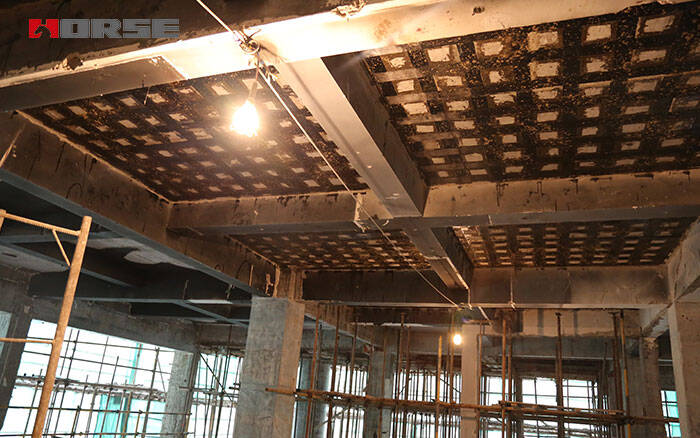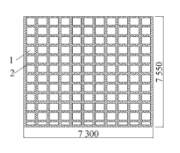Refuerzo de vigas y losas
Refuerzo de envoltura de polímero reforzado con fibra de carbono (CFRP)
Además de los métodos tradicionales de agrandar la sección transversal y envolver el acero, en los últimos años han aparecido algunos nuevos métodos de refuerzo, como el refuerzo con FRP preesforzado, el hormigón proyectado, la unión de acero y el refuerzo de envoltura de polímero reforzado con fibra de carbono (CFRP).

Con el rápido desarrollo de la economía de China, la construcción de ingeniería a gran escala está creciendo. En el proceso de construcción, la calidad del proyecto no está a la altura de los estándares debido al bajo nivel técnico o la gestión inadecuada, y aparecen varios problemas de calidad. En los edificios existentes también se encontrarán con esta situación, un uso a largo plazo de la estructura principal de un proyecto en el caso de cargas de humedad o vibración también provocará desconchado del hormigón, corrosión del acero, etc., lo que dará como resultado una reducción significativa de la resistencia estructural. Cuando la carga estructural cambia y la estructura original no puede cumplir con los requisitos de resistencia o rigidez, es necesario detectar y reforzar la estructura o los componentes. Además de los métodos tradicionales de agrandar la sección transversal y envolver el acero, en los últimos años han aparecido algunos
nuevos métodos de refuerzo, como el refuerzo de FRP pretensado, el hormigón proyectado, la unión de acero y el refuerzo de envoltura de polímero reforzado con fibra de carbono (CFRP).
La tecnología de refuerzo y reparación del hormigón con CFRP consiste en reforzar la estructura original mediante la unión de tejido CFRP a la superficie de la estructura. En general, es adecuado para las partes
de tensión de losas y vigas, partes de corte de vigas y columnas y pilares, partes con longitud de anclaje insuficiente de barras de refuerzo, refuerzo de columnas y pilares, y refuerzo de flexión, corte y tracción de
cerchas de techo. La fibra de carbono también se usa ampliamente en varios edificios industriales y civiles, estructuras, refuerzo antisísmico, antiagrietamiento, anticorrosión. En comparación con el hormigón
armado tradicional o el hormigón aglomerado con acero, la fibra de carbono tiene las ventajas de ahorro de espacio, construcción simple, sin necesidad de instalaciones de fijación en el sitio, fácil garantía de
calidad de la construcción, sin aumento del tamaño y peso estructural, resistencia a la corrosión, buena durabilidad, etc. Además, la adopción de este método puede mejorar en gran medida la vida útil de los
edificios y reducir el costo del refuerzo. Por lo tanto, la fibra de carbono ha atraído mucha atención como un material de refuerzo que marca una época.
1 Principio de diseño del refuerzo
En el cálculo de vigas y losas de hormigón reforzadas con CFRP, se descuida el efecto del hormigón en la zona de tensión. La deformación media del hormigón, el CFRP y el acero después de la flexión se ajusta
al supuesto de sección plana, y se adopta la relación tensión-deformación elástica lineal para el CFRP. Según el supuesto de sección plana, la deformación de la fibra de carbono debe ser ligeramente mayor
que la de la barra de refuerzo. Para simplificar el cálculo, la deformación por tracción de la fibra de carbono puede ser aproximadamente igual a la de la barra de refuerzo. Según el principio de tensión igual,
el área del CFRP se puede transformar en el área equivalente de las barras de acero, y luego se puede obtener el área equivalente de las barras de acero.
2 ejemplos de proyectos
Para un proyecto de palacio en una zona turística, no se ha calculado el soporte del encofrado y las bielas horizontales y verticales no son razonables, lo que da como resultado una rigidez insuficiente del
soporte. Cuando la resistencia del hormigón no ha alcanzado una cierta resistencia, la deformación del soporte del encofrado aumenta debido a la influencia de la carga del piso, y la losa del piso produce
una deflexión excesiva, lo que da como resultado grietas. El fenómeno de panal de abeja se produce en la parte inferior del tramo intermedio de algunas vigas del marco durante el vertido del hormigón, lo
que afecta gravemente la capacidad de carga. Después de la exploración en el lugar, la posición de panal de abeja de las vigas del marco no calificadas se refuerza con materiales de parcheo, y las losas del
piso con grietas en flexión se refuerzan con fibra de carbono para restaurar la capacidad de carga del diseño original.


3. Esquema de refuerzo
1) Para vigas y losas con superficies en forma de panal y con marcas de viruela, se pueden utilizar los siguientes métodos para reparar:
A. Determinar el área de reparación del hormigón.
B. Recortar el hormigón suelto en el área de reparación, limpiar el polvo y los escombros en el área hasta que el hormigón duro quede expuesto.
C. Reparar la superficie del hormigón con material de parcheo de hormigón (interfaz de cepillo, yeso, calandria, etc.).
D. Regar o cubrir con bolsas de plástico a tiempo después de 1-2 horas de la operación de reparación y mantener la superficie húmeda durante 2-3 días.
2) Refuerzo de la losa: para los pisos más grandes, se adopta el método de reforzar la parte inferior de la losa con láminas de fibra de carbono unidas en dos direcciones.
4 Tecnología de construcción
Especificación del material de fibra de carbono: el espesor de una sola capa es de 0,167 mm, la resistencia a la tracción no es inferior a 3400 MPa, el módulo de elasticidad a la tracción no es inferior a 2,3 x 105 MPa,
el alargamiento no es inferior al 1,6%.
5 Resumen
La estructura de vigas y losas de hormigón reforzado con fibra de carbono de este proyecto aprovecha al máximo las características de la tela de fibra de carbono, que es un material nuevo. Se puede ver que
la construcción con hormigón reforzado con fibra de carbono es simple, sencilla y segura, no ocupa espacio, puede mejorar eficazmente la eficiencia del trabajo, acortar el período de construcción, etc. Al mismo
tiempo, se garantiza eficazmente la calidad del refuerzo, la estabilidad de la estructura de hormigón armado es estable, la capacidad de carga está garantizada y se crean buenos beneficios económicos y sociales.